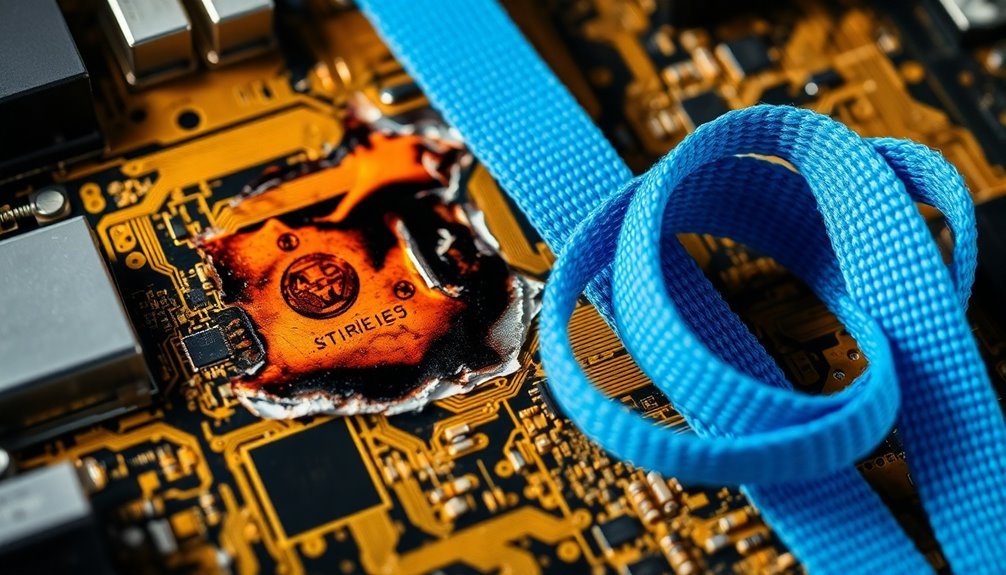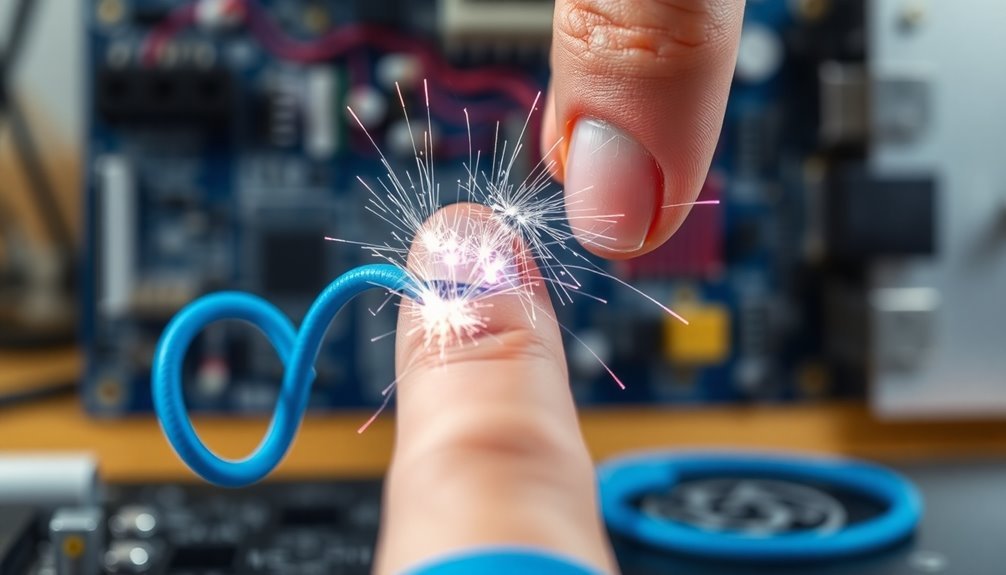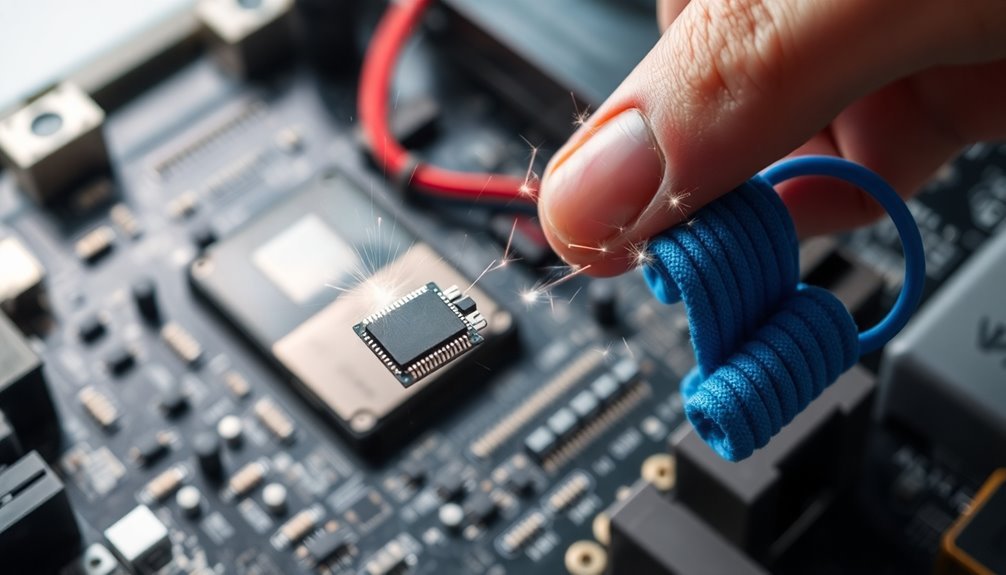You'll want an anti-static strap to protect your sensitive electronic components from costly damage, as even a tiny 25-volt discharge can harm equipment. When working with electronics, these straps keep you safely grounded and prevent static buildup that could lead to immediate failures or gradual performance issues. They're essential for meeting workplace safety standards and preventing fires in flammable environments. You'll save money by avoiding expensive repairs and replacement parts, while maintaining peak performance of your devices. Plus, they're versatile enough for use across multiple industries, from hobbyist electronics to professional manufacturing. Let's explore how these simple tools can safeguard your valuable equipment.
Protecting Your Electronic Investment

Why risk damaging your expensive electronic components when a simple anti-static wrist strap can protect your investment? Static electricity poses a serious threat to your electronic devices, and you mightn't even realize the damage is occurring.
The increase in ESD issues is largely due to the widespread use of insulating materials in modern electronics. While you can't feel static discharges below 3,000 volts, even a small 25-volt discharge can severely damage sensitive components. Connecting your wrist strap to a proper grounding point is essential for effective static discharge protection.
You'll face significant financial consequences if you don't protect your electronics from electrostatic discharge (ESD). Specialized circuit cards can cost up to $1 million, and even less expensive components require costly replacements when damaged.
What's worse, some ESD damage mightn't show up immediately, leading to latent failures that surface when it's too late.
You can prevent these costly issues by consistently using an anti-static wristband. These devices provide a safe path for static electricity to dissipate, protecting your valuable electronics from both immediate and long-term damage.
Don't forget to regularly maintain and inspect your wristband to guarantee it's working effectively. Remember, you're not just protecting individual components – you're safeguarding your entire investment in electronic equipment.
Safety Beyond Simple Static Control
While protecting your electronic investments is important, anti-static wristbands serve an even broader purpose in workplace safety. Antistatic wristbands incorporate built-in resistors to ensure safe discharge of static electricity.
You'll find these devices play a vital role in preventing serious workplace hazards, including fires and explosions in environments with flammable materials. When you're working with high-voltage equipment or handling sensitive components, these wristbands provide extensive protection that goes well beyond basic static control. The conductive materials in these wristbands ensure consistent grounding for optimal safety.
Your workplace safety depends on meeting essential regulatory standards like IEC-61340-5-1 and ANSI/ESD S20.20. You're not just following guidelines; you're actively preventing workplace injuries, burns, and potential health issues that static electricity can cause.
When you properly wear and maintain your anti-static wristband, you're contributing to a safer work environment for everyone.
You'll need to replace your wristband regularly and verify it's properly grounded to maintain its effectiveness. The investment in quality anti-static equipment pays off through reduced operational disruptions and enhanced productivity.
When combined with other ESD safety measures like anti-static mats and flooring, you're creating a complete safety system that protects both personnel and equipment while meeting all necessary compliance requirements.
Cost-Effective Prevention Against Damage

Investing in anti-static wrist straps represents one of the most cost-effective ways to protect expensive electronic components. The initial cost is minimal compared to the potential damage that static electricity can cause to your sensitive electronics.
You'll find that these simple devices provide significant long-term savings by preventing costly component failures and reducing the need for replacements. These devices dissipate static electricity safely through a grounded connection. Even small static discharges can cause significant damage to sensitive electronic components.
When you consider the high cost of electronic components and the time lost to repairs, wrist straps offer an impressive return on investment. They'll help you avoid expensive downtime and maintain productivity by preventing ESD-related incidents before they occur.
Regular inspection and replacement of wrist straps is far less expensive than dealing with damaged equipment.
You'll maximize your investment by properly implementing an ESD control strategy. This includes training your team on correct usage, conducting regular inspections, and maintaining thorough ESD protection protocols.
Meeting Industry Safety Standards
Understanding industry safety standards is essential when implementing anti-static wrist straps in your workplace.
You'll need to comply with key standards like ANSI/ESD S20.20, IEC 61340-5-1, and NFPA 77, which provide thorough guidelines for ESD control programs and static electricity management.
To meet these standards, you'll need to properly ground your wrist straps according to ANSI/ESD S20.20 requirements and verify they meet the performance specifications outlined in ANSI/ESD S1.1. Metal snap connectors must be securely fastened to coiled cords for proper grounding.
If you're working in explosive environments, you must also follow IEC 60079 guidelines for static control, while military contractors should adhere to MIL-STD-1686 requirements.
You'll need to establish ESD protected areas with anti-static flooring and controlled environmental conditions. Static charges as low as 25 volts can cause undetectable damage to sensitive electronics.
Your workstations must feature ESD-safe materials and proper grounding connections.
Don't forget to implement access control measures to restrict entry to authorized personnel only.
Remember to regularly test and maintain your grounding accessories, including wrist straps and ESD mats, to confirm they're functioning effectively.
This thorough approach helps you maintain compliance while protecting sensitive electronic components from ESD damage.
Professional Grade Equipment Protection

Professional equipment protection demands reliable anti-static solutions, especially when handling components worth up to $1 million. When you're working with sensitive electronics, even a minor static discharge of 25 volts can damage critical components like MOSFET transistors and laser diodes.
That's why you'll need an anti-static strap with a 1 megohm safety resistor to limit current flow and protect both you and your equipment.
Your investment in professional-grade equipment deserves thorough protection. Static damage isn't always immediately noticeable but can cause devastating effects:
- Immediate component failure, leading to costly replacements and production delays
- Gradual performance degradation that's difficult to diagnose and fix
- Future device failures that compromise equipment reliability
- Reduced lifespan of expensive electronic components
You can't afford to take chances with specialized circuit cards and sensitive equipment. By using an anti-static strap consistently, you're not just protecting valuable components – you're ensuring peak performance and preventing costly repairs.
In industries like aerospace manufacturing, where precision is paramount, anti-static straps are essential tools for maintaining equipment integrity and preventing undetectable damage that could lead to critical failures.
Frequently Asked Questions
Can Anti-Static Straps Expire or Wear Out Over Time?
Yes, your anti-static straps can wear out and expire over time. They'll show physical damage, fail continuity tests, and lose effectiveness through regular use. You should replace them based on manufacturer guidelines and testing results.
Should You Wear an Anti-Static Strap While Working on Laptops With Batteries?
You shouldn't wear an anti-static strap while working with laptop batteries. Always remove the battery first, then use the strap when handling internal components to protect them from static electricity damage.
How Tight Should an Anti-Static Wrist Strap Be Worn?
You should wear your anti-static wrist strap snugly but not too tight. It needs to maintain consistent skin contact while remaining comfortable. You'll want to fit one finger between the strap and wrist.
Does Humidity in the Room Affect the Effectiveness of Anti-Static Straps?
Yes, humidity does affect your anti-static strap's performance. While they'll work in any conditions, you'll get better results in 40-60% humidity. Lower humidity increases static risks, so you'll need extra precautions.
Can Multiple People Share the Same Anti-Static Strap Safely?
You shouldn't share anti-static straps. It's unsafe due to infection risks, potential allergic reactions, and decreased effectiveness. Plus, shared straps deteriorate faster and may compromise cleanroom standards. Always use your personal strap.
In Summary
Don't risk damaging your valuable electronics when there's a simple solution available. You'll find that an anti-static strap is an essential tool that provides reliable protection for all your sensitive components. Whether you're a professional technician or a DIY enthusiast, investing in this basic safety equipment will save you money and guarantee you're meeting industry standards while working confidently with your electronic devices.





Leave a Reply